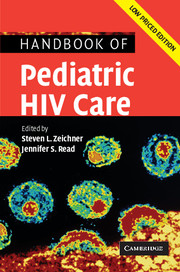Book contents
- Frontmatter
- Contents
- List of contributors
- List of abbreviations
- Foreword
- Preface
- Part I Scientific basis of pediatric HIV care
- Part II General issues in the care of pediatric HIV patients
- 3 Diagnosis of HIV infection in children
- 4 Prevention of mother-to-child transmission of HIV
- 5 Routine pediatric care
- 6 Emergency evaluation and care
- 7 Adherence to antiretroviral therapy in children and youth
- 8 Adolescents and HIV
- 9 Growth, nutrition, and metabolism
- 10 Neurobehavioral function and assessment of children and adolescents with HIV infection
- Part III Antiretroviral therapy
- Part IV Clinical manifestations of HIV infection in children
- Part V Infectious problems in pediatric HIV disease
- Part VI Medical, social, and legal issues
- Appendix 1 Formulary of antiretroviral agents
- Appendix 2 National Institutes of Health sponsored clinical trials for pediatric HIV disease
- Appendix 3 Selected HIV-related internet resources
- Appendix 4 Selected legal resources for HIV-infected children
- Index
- References
5 - Routine pediatric care
Published online by Cambridge University Press: 23 December 2009
- Frontmatter
- Contents
- List of contributors
- List of abbreviations
- Foreword
- Preface
- Part I Scientific basis of pediatric HIV care
- Part II General issues in the care of pediatric HIV patients
- 3 Diagnosis of HIV infection in children
- 4 Prevention of mother-to-child transmission of HIV
- 5 Routine pediatric care
- 6 Emergency evaluation and care
- 7 Adherence to antiretroviral therapy in children and youth
- 8 Adolescents and HIV
- 9 Growth, nutrition, and metabolism
- 10 Neurobehavioral function and assessment of children and adolescents with HIV infection
- Part III Antiretroviral therapy
- Part IV Clinical manifestations of HIV infection in children
- Part V Infectious problems in pediatric HIV disease
- Part VI Medical, social, and legal issues
- Appendix 1 Formulary of antiretroviral agents
- Appendix 2 National Institutes of Health sponsored clinical trials for pediatric HIV disease
- Appendix 3 Selected HIV-related internet resources
- Appendix 4 Selected legal resources for HIV-infected children
- Index
- References
Summary
Introduction
HIV infection is a chronic illness with diverse clinical manifestations and psychosocial challenges. The routine care of HIV-infected children demands a dedicated multidisciplinary approach from a variety of health care professionals including medical sub-specialists, nurses, psychiatrists, psychologists, dentists, social workers and case managers. The HIV primary care provider, while ensuring health maintenance and preventing disease, must serve as the coordinator of an array of services crucial to the management of these children in the context of the family. Important management considerations attend the care of both HIV-exposed children and those children ultimately identified as HIV-infected.
Care of the HIV-exposed infant
Routine care for the infant born to an HIV-infected mother should begin well before the infant's birth. Clinicians should collaborate with the mother's primary care providers to minimize the risk of HIV transmission. Care of the infant after birth includes continued interventions to reduce the risk of HIV infection, as well as HIV diagnostic evaluations and routine infant care (Table 5.1). Care of the HIV-exposed newborn in the hospital begins with a thorough maternal history, including HIV disease status [HIV RNA concentration (viral load), CD4+ lymphocyte count, and HIV-related complications), receipt of interventions to prevent mother-to-child transmission (e.g., antiretroviral prophylaxis, cesarean delivery before labor and before ruptured membranes), and history of other infections (e.g., syphilis, herpes simplex virus, hepatitis B and C, cytomegalovirus, toxoplasmosis, gonorrhea, or tuberculosis (TB)).
- Type
- Chapter
- Information
- Handbook of Pediatric HIV Care , pp. 134 - 176Publisher: Cambridge University PressPrint publication year: 2006

